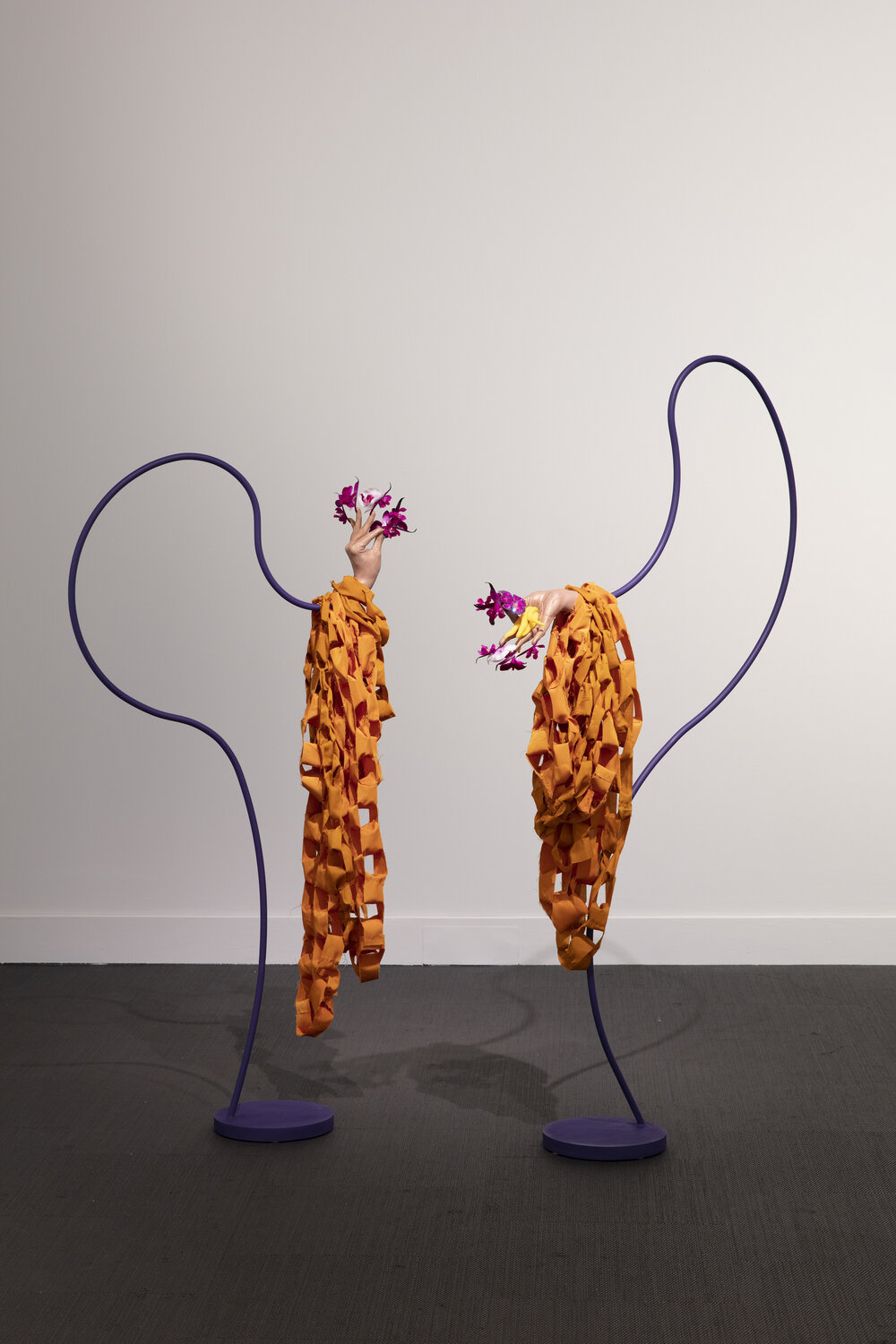Nathan Beard’s Limp-wristed Gestures are a pair of gestural silicon casts of the artist’s hands, based on Thai dance movements and Buddhist statues. The first inspiration for these works is the disembodied, rubber limbs found in nail salons—the plastic hands that showcase nails with glamorous surrealism. For Beard, this prosthetic sight ricocheted into a complex association of cultural signifiers referencing his Thai-Australian cultural background, by drawing from the hand gestures of traditional Thai dance, Lahkon Nai, and the fingernails of Buddha.

Nathan Beard, Limp-wristed Gesture (detail), 2020, silicon, found objects, acrylic nails, Swarovski Elements, cotton, wax, Fenty Beauty, Tom Ford Beauty, nail polish, painted steel, installation size variable.
The gaze of self and others certainly modulates this connotative play, and Limp-wristed Gestures inhabit this chaotic stage with a kitsch uncanniness. The stunning hand objects—held on colourful stands of coated steel—assemble a myriad of found materials to reconfigure the drama of looking. These referents range from fish sauce to rare cosmetics, and fake orchids to pieces of monk robes’ fabric. Some of them are in the fantastic hand stitched, fabric garland that hangs where the sculptural wrist meets their base, while others rest in their palms. These familiar objects become unfamiliar, inducing the mysterious sense of eeriness caused by doubles, such as dolls. Indeed, the doubles in Limp-wristed Gestures are glamorous shadows of the artist, for they cast his body to produce an intensely alluring sight.
Beard’s hand objects stand morbidly lim yet beautified with cosmetics to remind us of morticians, who apply make-up on vacant bodies in the morgue. Art historian Hans Belting sees the corpse as an image of life, for the cadaver is indexical of an absent presence—an imprint of dissipated consciousness. Limp- wristed Gestures are a disembodied picture, an inanimate trace of evaporated presence, because they hold evidence of cultural life. This ‘cultural life’ is the perceptual flow of culture as met by the artist, within a sequential narrative of identity making. Same as life resemble an episodic encounter with a protagonist (ourselves), cultural formation is a serial and filmic experience of insights, progressions, and digressions. Limp-wristed Gestures ar not the carcass of any one culture, they are the image of significant thought-moments: fleeting instances, remembered and performed within the theatre of identity. It is the mummification of triviality—the small things we grasp and recall when constructing ourselves—now immortal. These are the shadows of the artist as he negotiates the connotative endlessness of his Thai-Australian heritage. They are cultural flashes, like snapshots in a memory reel.

Nathan Beard, Limp-wristed Gesture (detail), 2020, silicon, found objects, acrylic nails, Swarovski Elements, cotton, wax, Fenty Beauty, Tom Ford Beauty, nail polish, painted steel, installation size variable.
These impressions resurface as extremities from the deep abyss of time passed, now detached from a body or whole, to float unboundedly over a haunting garden of signifiers. Like a miraculous return to Paradise Lost, where Adam and Eve renounced eternity by biting the apple of knowledge, a myriad of fleeting thought moments reincarnate in Limp- wristed Gestures, to claim immortality. The orchid, held by one of the disincarnated hands, is a memory object that enjoys resuscitation. For Beard recalls how this evocative flower proliferates in endless representations of Thailand (even used to create an exotic ambience on Thai Airways’ first class), creating a stereotyped icon of Thai-ness. Following this recall, he incorporates fake orchids sourced from markets in Bangkok by placing them in his dismembered hands, creating the illusion that the sculptures are holding a flower.
This makes them look like they are hovering in a vast garden of meaning, where they pick up spirits from the underworld of remembrance, and renounce their body in favour of new significations. The orchid is a revived image that emerges from the recesses of the artist’s recollection, once immaterial in the imagination, it finds a new vessel in this visceral assemblage.
This is a process of divine raiding, stealing souls from Hades by pulling and re-embodying phantoms of intercultural memory. Other images rescued by Beard include Tiparos and Squid fish sauce, which make an appearance as (admittedly cute) miniature bottles, referencing the culinary vistas of the artist’s childhood. The work expands on this diasporic referent with copper Swarovski Elements that, in the words of Beard, ‘look like crystalline fish sauce’.
Following this trail, he also ordered a discontinued Tom Ford nail polish calledBurnt Topaz to use as a base for the Swarovski Elements. The base colours are in fact an abstraction of the Thai Airways logo, which invokes a Deep Violet purple and a pinkish Flirt, as found in the airline’s palette.
Thus, coining this associative method of remembrance as a divine raiding conveys a supernaturalised interpretation but also a fabulous heist, for the connotative echoes of divinity inevitably resonate with John Water’s Divine—who approaches drag with a glittery, abject sensibility. Nathan Beard shares this perverse stance, as his works show a latent sense of undecipherable strangeness, shrouded in glamour. Beard is also a divine mirror that reflects the Western gaze back on itself, creating a magical rupture in racial relations, same as how Perseus defeats Medusa by reflecting her mythological stare. For the content of his work is made of materials that are gazed and signified to create a coherent notion of Thai-ness. He conjures and reconstitutes this Thai-ness with aberrant glitz in Limp-wristed Gestures, where its embodied semiology stays still, becoming the beautified corpse (or image) of cultural impressions.